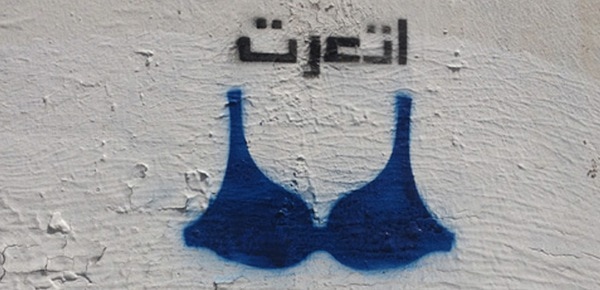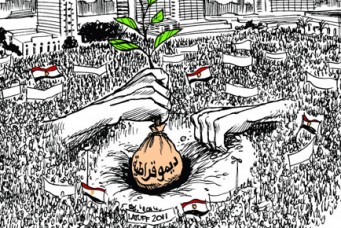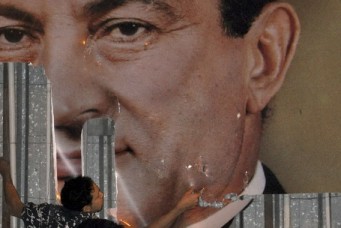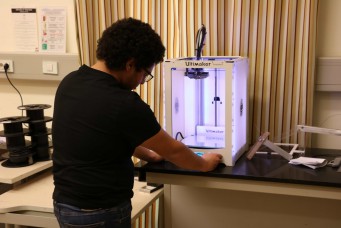Revolution to Revolution
Artists have spent a century claiming Egypt for the Egyptians. Now the powerful murals of January 25 have created a new public space dedicated to every citizen.

No to Stripping the People, by Bahia Shehab, Cairo, March 24, 2012. Bahia Shehab
Artistic creation and political discourse have been linked in the history of Egypt since the reign of Muhammad Ali. From the nineteenth century, through the 1920s and 1930s, and through the eras of Gamal Abdel Nasser, Anwar Sadat and Hosni Mubarak until the present moment, public space has been the theater of political and cultural debates that find their reflection in visual representations. Many landmarks mirroring this dynamic between art and politics remain. Public monuments convey the major values of the official discourse over time as they successively construct or deconstruct the image of the nation.
Most interesting, perhaps, are the roles played by the claimants of public space. One after another, political and cultural actors have been the decision-makers of the ideas that should be conveyed through visual landmarks in collective spaces. With the January 25, 2011 uprising in Tahrir Square, new actors have emerged, claiming their rights to public spaces that have historically constituted arenas for the construction of identities. Egyptian citizens aim to recover the notion of public space, which simply does not exist as a social space provided by the state and conceived for the citizen. The use of public space for artistic expression in Egypt today—the flourishing of murals and graffiti painted and painted again by young Egyptian revolutionaries—represents a new milestone in the interaction between arts and politics in Egyptian history.
The failure of the state in relating to the citizen through public space significantly reveals itself in social media. That is to say that the new virtual sub-space provided by social media underlines the need to fill the gap of an inexistent space by renewing the ancient concept of the public forum. Thus, the multilayered visual representations in public space, whether in rupture or in continuity with the past, constitute a palimpsest, whose decryption indicates major socio-political and cultural change.
Egypt’s Awakening
During the nineteenth century, the formation of the new Egyptian urban landscape was dominated by the work of European artists and architects. In the context of the modernization and extension of the cities of Cairo and Alexandria, Khedive Ismail called upon French Orientalist sculptors, such as Charles Cordier and Alfred Jacquemart, to create equestrian monuments to commemorate the khedivial lineage. These monuments correspond to a conventional image of the “oriental sovereign” established by Muhammad Ali. The ruler is generally mounted on a horse decorated by the crescent emblem, wearing a tarbush or a turban, his arm stretched out in a commanding gesture.
This Orientalist typology of self-representation dominated the official artistic direction until the beginning of the twentieth century. This trend was prevailing to the point that the first monument dedicated to one of the most renowned Egyptian nationalist leaders, Mustafa Kamel, was commissioned, after his death in 1908, to a French Orientalist sculptor named Léopold Savine. The monument, which still stands in downtown Cairo, represents Mustafa Kamel in oration, wearing the tarbush and pointing his finger to the ground in sign of domination. His right hand leans on the bust of a sphinx, recalling the prints of the Description de l’Égypte and enhancing the charisma of the leader. The official inauguration of the monument in a Cairo square was postponed by the British for forty years and was finally unveiled by King Farouk on Suares Square, renamed at the inauguration in honor of Mustafa Kamel.
Egypt had to wait until the aftermath of the 1919 Revolution led by Saad Zaghloul to see a monument in a public space created by an Egyptian artist: the sculptor Mahmoud Moukhtar, who graduated from the School of Fine Arts in Cairo and the École des Beaux-Arts in Paris. This famous and highly symbolic monumental sculpture entitled Egypt’s Awakening (Nahdat Misr) was inaugurated on May 20, 1928, on Bab El-Hadid Square in front of the Cairo railway station. It was later moved by Gamal Abdel Nasser to the front of Cairo University.
Financed by a national subscription initiated by a committee formed by members of the Wafd Party, Egypt’s Awakening contributed to the creation of a new visual image of the nation, breaking away from the previous Orientalist representations. The official inauguration ceremony took place with great pomp under the auspices of King Fuad in the presence of ministers, dignitaries of Al-Azhar, representatives of the Coptic Church, as well as consuls, officers, and members of the parliament and senate. Speaking at the ceremony, Prime Minister Mustafa Al-Nahas proclaimed the monument to be a symbol of Egypt’s “national awakening” (nahda qawmiyya).
At the time the monument was conceived, Moukhtar pioneered the visual trend of reinvention by using the ancient material of granite and constructing the image of the nation through a double allegory: ancient Egypt and contemporary ruralism, incarnated as a sphinx and a peasant. These two themes would go on to constitute the leitmotivs of political discourse throughout the 1920s and 1930s. Egypt’s Awakening was echoed a few years after its inauguration in Tawfiq Al-Hakim’s novel, Return of the Spirit (Awdat al-Ruh). The novel places the peasant in the center of the narration as the guardian of an “Egyptian spirit” that will “return” thanks to the solidarity of the 1919 Revolution initiated by the charisma of one single individual: Saad Zaghloul. After his death, this figure himself became a pharaoh of modern Egypt. The two monuments dedicated to him in Cairo and Alexandria, created by Moukhtar, as well as his mausoleum designed by architect Mustafa Fahmi, represent the climax of the neo-Pharaonic style in Egyptian modern sculpture and architecture.
In the context of the 1919 Revolution, Alexandrian painter and diplomat Mohamed Nagui was the first Egyptian artist to execute a decorative painting dedicated to a public institution, the Egyptian parliament, in 1922. Titled Renaissance of Egypt or the Cortege of Isis, the work celebrated the inauguration of the parliament and the proclamation of a new constitution; it remains on display in the Egyptian senate. The painting represents the triumphal cortege of the goddess Isis riding on a chariot led by two buffaloes and escorted by a crowd of ancient and contemporary figures. Isis, representing Egypt, is depicted as the announcer of a cultural rebirth.
Through this work, Nagui created the genre of modern epic or historicist monumental painting, aiming to rewrite a “national history” that had been dominated by Orientalist European scholars. However, while set in a pharaonic landscape, Nagui’s painting refers mainly to mythological paintings of the European Renaissance, such as certain representations of the Triumphal Cortege of Diana.
At the beginning of the 1950s, under Gamal Abdel Nasser, Pharaonic heritage gradually made way for other references inspired by Egypt’s Islamic heritage. For instance, unlike the mausoleum of Saad Zaghloul, the tomb of Mustafa Kamel, inaugurated by Nasser in 1953, was designed in a neo-Mamluk style. Besides being considered as the highest degree of refinement of Egyptian Islamic art and architecture, the Mamluks also embodied military power. Moreover, contrary to the theme of ancient Egypt that was geographically limited, the neo-Islamic trend complied with a new image of cultural identity that reflected the pan-Arab orientation of Nasser’s regime.
Blue Bra Girl
Sixty years of military-backed rule in Egypt inexorably led to the events of January 25, and a burst of related artistic creation. Several artists revisited the historicist genre that Nagui initiated in the 1920s. Khaled Hafez, for example, who addresses the questions of cultural memory in his work, produced several monumental paintings in his series, Tomb Sonata in Three Military Movements (2012). Hafez plays with references to ancient Egypt and icons of American popular culture, thus bringing to the fore the complexity of the notions of authenticity and identity. Also, in her impressive murals artist Alaa Awad illustrated contemporary events interpreted in a neo-Pharaonic style. As much as Nagui referred very clearly to the heritage of ancient Egypt as the basis of national identity in Egypt’s Renaissance, the contemporary creations of Hafez and Awad question the ambiguity of the construction of identities. The triangulation of mass media, Western culture and Egyptian heritage thus appears implicitly in public spaces or galleries.
Another echo of the 1919 events is the role played by women in the public space. For instance, the gesture of the peasant unveiling in Egypt’s Awakening is significant. At the time the sculpture was executed, this feminine figure paid tribute to the emancipation of Egyptian intellectual women who, besides being activists and supporting the national cause, played an important role as patrons of the arts. Moukhtar thus recalled a contemporary event through this gesture: the unveiling of two prominent figures of Egyptian feminism, Huda Shaarawi and Ceza Nabarawi, in a public act on a platform of the Cairo railway station in 1922. The uprisings three years earlier were marked by the presence of women in the public space, a space that was previously difficult for them to access. The press had significantly instrumentalized the images of women’s demonstrations in order to reinforce the mainstream discourse of national unity. However, despite their commitment to the struggle for independence, after the victory of the Wafd Party, women remained completely deprived of their rights within the political sphere.
Similarly, the media largely broadcast and exploited the presence of women in public space during the 2011 uprisings in Egypt. The image of the “blue bra girl,” a demonstrator who was brutally beaten by security forces in Tahrir Square on December 17, 2011, became iconic. The image was reinterpreted by the Moroccan artist Zakaria Ramhani in a work entitled You Were My Only Love in 2012. It depicts the violence of “military gorillas” brutalizing the protestor under the disapproving gaze of Van Gogh. Furthermore, the “blue bra” appeared as stenciled graffiti on the walls of downtown Cairo as a symbol of resistance.
The astonishing rapidity with which iconic images circulated from the media to the streets and to the global art market underlines the emergence of a new dialogue between these spaces. More feminine images progressively emerged in the urban landscape, such as the effigy of Samira Ibrahim, who was forced by security forces to undergo a “virginity test” in March 2011.
It is interesting to note that Moukhtar’s Egypt’s Awakening, the symbol of the struggle for independence, occupied the center stage in the violent clashes between Muslim Brotherhood demonstrators and security forces in July 2013. Protesters climbed up the monument and covered it with anti-military slogans, a collective act by these new claimants of the political sphere.
Bye Bye Hosni
At the beginning of September 2012, one of Alaa Awad’s murals was whitewashed by the authorities. The wall chosen by the artist for this mural was not anodyne: it was the wall that follows the Mohammed Mahmoud Street opening onto Tahrir Square which had witnessed successive clashes between demonstrators and security forces since January 2011. This wall became famous, and its successive transformations have been carefully recorded and archived by bloggers and on social media. For three years, its surface has been constantly whitewashed and painted over.
The whitewashing of Awad’s work did not last longer than a few hours and was painted over with the face of a man sticking his tongue out and defying the authorities with the slogan: “Erase it again, regime of cowards.” A few hours later, the wall was entirely covered by graffiti, slogans and effigies of martyrs. But the following day, other claimants of the wall had repainted over these same images. This ongoing process intrigued passersby; the walls of Mohammed Mahmoud Street became a space of debate, a sort of Speaker’s Corner. Thus the dynamic of whitewashing reflects the tensions between the various claimants of public space and a fortiori, the claimants of a space within the political sphere.
The walls were also the material space for putting an end to the cult of personalities. Many images ridiculed the previously glorified effigies of political rulers that used to be displayed all over the urban landscape. Since the era of Gamal Abdel Nasser, the cult of the charisma of Egyptian leaders dominated public space. However, after 2011, a rupture occurred that was reflected on the walls of the city, as well as in art galleries.
In March 2011, the artist Ali Ali presented a collection of his works entitled Thirty Hosnis at the Articulate Baboon Gallery in Cairo, which showed a series of serigraphies of the portrait of the former President Hosni Mubarak repeatedly reproduced in the tradition of American pop art. Ramhani also addressed the end of the propaganda of the Mubarak era in his work entitled Bye Bye Hosni. The painting depicts someone tearing down a giant poster of Hosni Mubarak’s portrait. On the back of this individual, one can see the Facebook “Like” symbol.
The cult of the personality of political leaders was replaced by the glorification of the portraits of Egyptian citizens: the martyrs. Bringing the young activists who died for their beliefs out of anonymity appears as a shift in the idea of public space itself. Powerful murals, such as those of artists Ammar Abu Bakr or Ganzeer, paid tribute to the martyrs and consequently created a new space dedicated to every Egyptian citizen. This is a story of the use of public space, which reflects a close relationship between art and politics. In this sense, contemporary interventions in public space represent much more than street art creations, as they identify a space that should be conceived for the collective and cannot function as the sole property of the state.
Nadia Radwan is an assistant professor of art history at the American University in Dubai. From 2007 to 2013, she served as a research assistant to the Institute of Environmental Sciences as part of the Globalization, Urban Planning, and Governance team at the University of Geneva. In 2011, she conducted research at the Egyptian National Archives with the support of a Swiss National Science Foundation scholarship. She has contributed to Docomomo Journal and Quaderns de la Mediterrània.
Correction August 13, 2014: An earlier version of this article incorrectly used a feminine pronoun in a reference to artist Alaa Awad.
Subscribe to Our Newsletter





